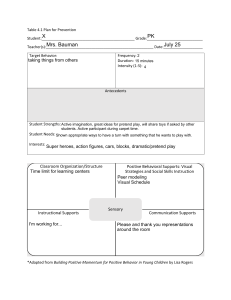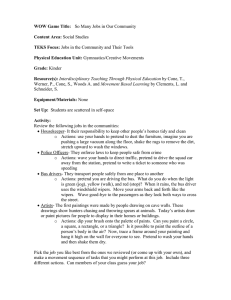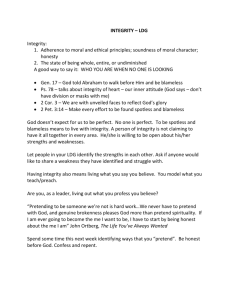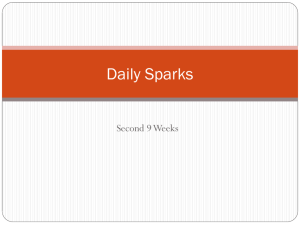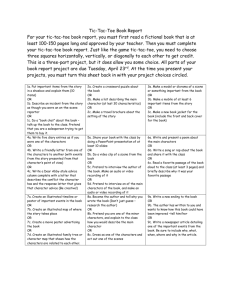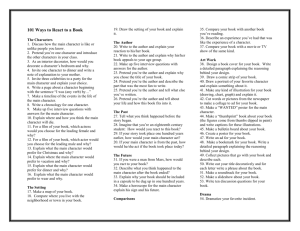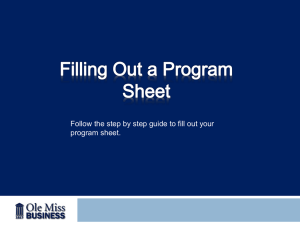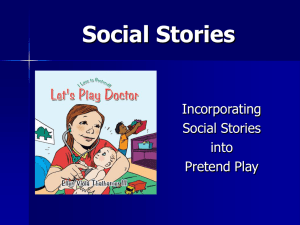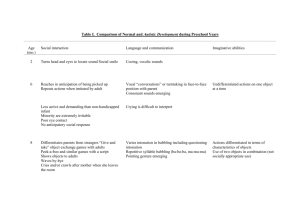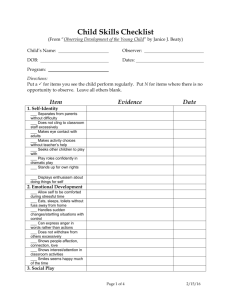Goals and Skills for the PreK Centers / Areas
advertisement
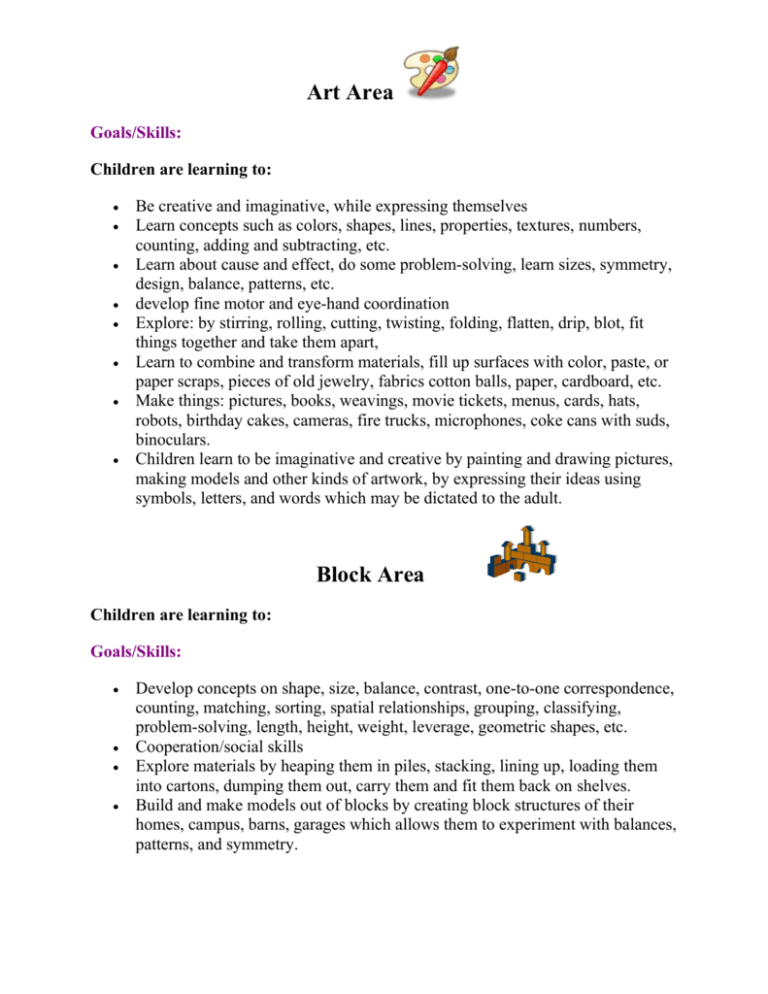
Art Area Goals/Skills: Children are learning to: Be creative and imaginative, while expressing themselves Learn concepts such as colors, shapes, lines, properties, textures, numbers, counting, adding and subtracting, etc. Learn about cause and effect, do some problem-solving, learn sizes, symmetry, design, balance, patterns, etc. develop fine motor and eye-hand coordination Explore: by stirring, rolling, cutting, twisting, folding, flatten, drip, blot, fit things together and take them apart, Learn to combine and transform materials, fill up surfaces with color, paste, or paper scraps, pieces of old jewelry, fabrics cotton balls, paper, cardboard, etc. Make things: pictures, books, weavings, movie tickets, menus, cards, hats, robots, birthday cakes, cameras, fire trucks, microphones, coke cans with suds, binoculars. Children learn to be imaginative and creative by painting and drawing pictures, making models and other kinds of artwork, by expressing their ideas using symbols, letters, and words which may be dictated to the adult. Block Area Children are learning to: Goals/Skills: Develop concepts on shape, size, balance, contrast, one-to-one correspondence, counting, matching, sorting, spatial relationships, grouping, classifying, problem-solving, length, height, weight, leverage, geometric shapes, etc. Cooperation/social skills Explore materials by heaping them in piles, stacking, lining up, loading them into cartons, dumping them out, carry them and fit them back on shelves. Build and make models out of blocks by creating block structures of their homes, campus, barns, garages which allows them to experiment with balances, patterns, and symmetry. Pretend and imitate combining blocks with other toys such as little people, animals, transportation vehicles and creating play scenarios with houses, barns, rivers, lakes, boats, roads, and fences. Play games with their own made up rules. Make their plans and express their intentions; solving problems that arise with materials and peers. Learn about spatial relations, logic and number concepts and they sort and compare objects and people; they notice similarities and differences. Recognize and discuss the attributes of objects, events and people. House or Kitchen Area The dramatic play pretend area is often the place where the most imaginative and involved play occurs. Goals/Skills: Children are learning to: Understand and experience the adult world through imitation Express feelings and emotions Understand their world better Imitate grown-ups thus experience a sense of power Develop their creativity and imagination Practice different roles Use abstract thinking when improvising and symbolic use of items Explore by stirring, filling, emptying, pouring, shaking, mixing, rolling, zipping, buttoning, folding, snapping, brushing, and by trying-on and removing clothing. Solve problems as they arise with the materials and with each other Make plans and carry them out Pretend and imitate they can cook, serve, eat “meals”, care for babies, go shopping, go to work, dress up, have parties; go to weddings, and movies, go to the beauty shop and pretend to put on make-up Work with others, express their feelings and use elaborate language, discuss rules of play and make up their own rules Act out familiar roles and re-enact events they have experience Water / Sand Table (Media/Sensory Table) Children are learning to: Goals/Skills: Develop their concepts and language (empty/full, warm/cold, wet/dry…) Development and control their fine motor Do math concepts (more/less, spatial concepts, measuring, comparing, properties, volume, mass, cause and effect, texture, adding, subtraction, etc.) Tension release/relaxation – appropriate outlet for anger Explore materials such as (water, sand, pebbles, leaves, shaving cream, Styrofoam pieces, beans, etc.) mix, dump, dig, fill, empty, heap, pour, sift, mold pat and splash. Make things to pretend with such as cakes, houses, roads, lakes for floating boats, etc. Solve problems when they arise with materials and peers Learn spatial concepts by discovering the properties of pliable materials, tactile materials and learning to work together. Small Toys (Manipulatives) Goals/Skills: Children are learning to: Develop their fine motor muscles and control (preparation for holding a pencil) Concentrate and complete a task Develop their self-esteem and feeling of control and mastery Developing concepts such as patterning, sequencing, matching, order Explore materials by emptying and filling different containers; taking apart and putting together other materials, making patterns with all kinds of materials; sorting objects and match; using magnets, magnifying glasses and balance scales Imitate and pretend while using small toys and structures using small blocks or legos Make things out of legos, Tinkertoys, blocks, construction sets, hallow blocks, pegs and pegboard, etc., Play games and make up own roles, role-play stories read in the classroom Sort and compare objects noticing similarities and differences in the characteristics such as color, shapes, design, size, etc. Science and Exploration Area Goals/Skills: Children are learning to: Experience and explore the world around them Problem solve and explore materials Make guesses and estimates of objects, ideas, and events Develop their observation skills specifically using their five senses (touching, seeing, hearing, smelling, and tasting) Use simple tools such as magnifying lenses, safety glasses, simple microscopes, balances, non-standard measuring units, jars, bowls, sponges, paper, paper clips, magnets, balls of different sizes, boxes, Practice drawing and writing their observations in journals Discover and discuss patterns in the environment and on objects and events Sort objects by size, shape, weight, color and distinguishing marks Discuss and gather objects or creatures to review life cycles (butterflies, ladybugs, or mealworms) Learn to count, number, date, describe and share information LIBRARY AREA (Book Nook/Quiet Corner) Goals/Skills: Children are learning to: Love and appreciate books and literature That books are sources of information and can answer our questions Pre-reading concepts such as the written word is talk written down, made with symbols and stories are read from right to left, top to bottom, how to sequence; letter recognition; language patterns and development; new concepts and vocabulary; etc. Explore print materials such as picture books, big books, predictable books, poetry, informational books, newspapers, catalogs, magazines, etc. Create and write stories, notes, pictures, journals, and books. Learn to enjoy books and stories being read or reading themselves, and begin writing and reading words themselves Pretend to read by following the pictures, learn to care for books, parts of the books, and share stories with each other Child Care Lounge, (2009). Preschool and childcare learning environments and classrooms. Retrieved on January 14, 2010 from http://www.childcarelounge.com/environment/classarea.htm. Extensions: Newsletter of the High/Scope Curriculum, (1996). High/Scope classroom hint. 10 (5).
